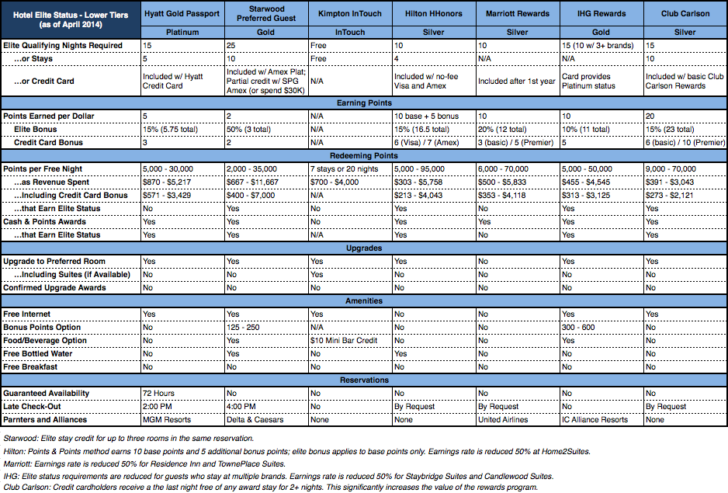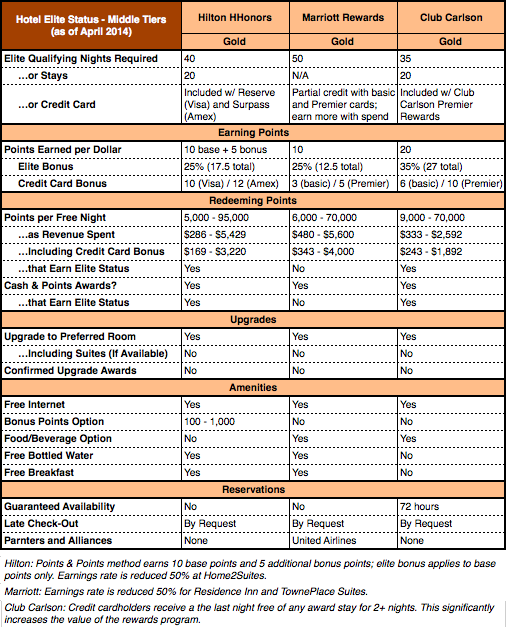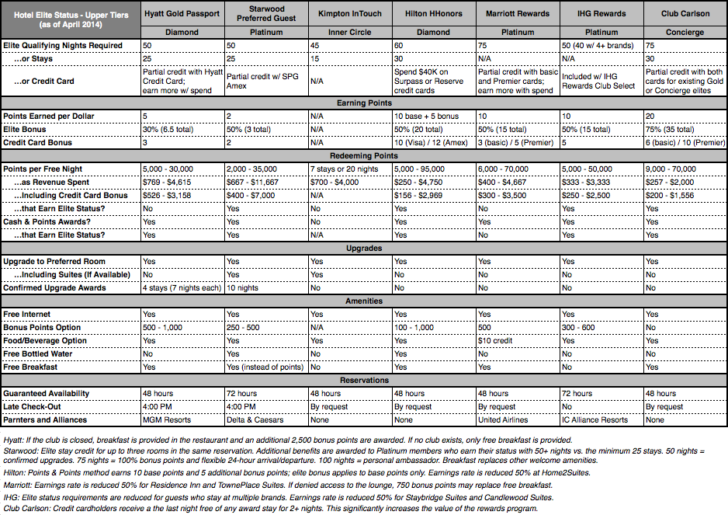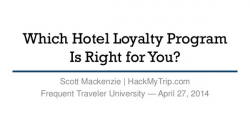This month I’ve been updating my comparison tables of hotel loyalty programs, and a big thanks is due to everyone who has helped point out corrections. (A few more than usual this year….) I started creating these tables for airlines and hotels in 2013 as a sort of “cheat sheet” to help you pick the best loyalty program for your needs. Everyone has different travel patterns, values different benefits, and will come to his or her own conclusions. But with the right information I hope you find the process much easier. Check out my airline comparison tables when you’re done here.
I try to distinguish between fact and opinion on this blog. The information in the updated tables is correct as far as I’m aware and is drawn directly from the programs’ own web sites. You may also download a PDF of all three tables or click on an image to see a larger view.
My goal was to see what programs promise — not what actually happens in practice. But I’ll also provide my personal commentary and opinion in each section.
Lower Elite Tiers
There is very little reason why anyone reading this blog should have low-level elite status with a hotel. Not because I’m being snobbish but because it’s so easy to get “free” elite status in a middle or upper tier with a co-branded credit card, often one that provides a free night each year worth more than the card’s annual fee.
Most lower elite tiers provide little more than a “preferred” room (e.g., no view of the dumpster) and free WiFi. The Internet access, at least, is become less important now that more chains are offering it for free to all their guests. Anyone with the gumption to talk to a manager can probably resolve the bad view, as well.
Hyatt Platinum and SPG Gold stand out. SPG Gold has fairly high requirements for elite status, and it’s the only one that requires a super-pricey Amex Platinum Card to get it for free. But it also provides some decent benefits, including welcome bonus points, that make it more comparable to a mid-level elite tier.
Whereas SPG Gold stands out because of its high quality, Hyatt Platinum deserves attention despite its benefits. Like many other low-level elite tiers it doesn’t seem very useful. But it’s included with the Hyatt Credit Card, which comes with a free night each year at a Category 4 hotel. This is often worth more than the card’s $75 annual fee, and I often use my free night for New Year’s Eve. It also provides matching M Life Gold elite status at MGM Hotels & Resorts in Las Vegas, with benefits such as VIP access to night clubs and taxi queues.
Middle Elite Tiers
Mid-level status is my bread-and-butter. I have at least Gold status in every program examined hear, yet 95% of my hotel stays are with Hyatt and Starwood. How? I get status for free through matches (my United status provides me Marriott Gold); I use mis-targeted promotions that offer free elite status trials (Club Carlson had one just last week); or I apply for a credit card card (Hilton is notorious for this practice).
As a mid-level elite you can usually be sure to get better attention from a hotel. Anyone can stumble into low-level elite status with 4 or 5 stays at Hilton and Hyatt. At least the tricks I just mentioned require some thought. You stand a better chance of getting some bonus points on arrival, the upgrades are more likely to include the executive floor, and you may even receive lounge access or free breakfast. These are just some of the perks of Hilton Gold status, long recognized as among the most rewarding of mid-level hotel elite tiers.
Don’t forget to include SPG Gold, which may Starwood’s lowest elite tier but probably deserves to be compared with more rarefied company due to greater benefits and qualification criteria. I still think Hilton has it beat. Club Carlson does not necessarily have a great Gold tier, but it is also worth mentioning because it is included with the Club Carlson Premier credit card — and that is something special. Club Carlson credit card holders receive the last night free on any award stay of two or more nights. Many couples will book alternate two-night stays with separate accounts and redeem half as many points for their vacation.
Upper Elite Tiers
If you’re staying 50 or more nights a year at a hotel, you really should pay attention to your benefits and make sure you pick the most rewarding program for your personal needs. You could get by with as few as 25 nights with Hyatt and Starwood by booking several one-night stays, but that is rarely practical. (Remember, they must be non-consecutive stays to count individually.) Other programs, such as Marriott, Hilton, and Club Carlson, may be looking for 60-75 nights.
Hyatt and Starwood win again in this round. They offer generous upgrade benefits, including the ability to confirm an upgrade in advance (Hyatt) or at least request priority consideration over other guests (Starwood). Starwood is also one of the very few chains that promises an upgrade to a standard suite if available and additional “super elite” tiers when you stay 50, 75, or 100 nights. Kimpton also offers a suite upgrade if available — and many other unique benefits like a free night at new hotels — but with so few properties it is difficult to maintain Inner Circle status.
I’ll point out here that while many chains may exclude suites from their complimentary upgrades at check-in (Hyatt), it’s possible that hotel management may choose to exceed expectations. I’ve been very fortunate. Other programs include a suite as one of many options (Marriott) but this is not the same as Starwood and Kimpton’s policy. Marriott provides a long list of eligible room upgrades for Platinum elite members. Although that list includes suites, the many other options suggest, in effect, that as long as it isn’t the worst room in the hotel they have satisfied their obligation.
I consider it frustrating when a program like Marriott Rewards has such high standards to achieve elite status and yet guarantees so little to its members. Marriott and IHG both require qualification on nights alone, not stays, but Marriott’s threshold is so much higher (while IHG hands it out to credit card holders). Granted, Marriott also tends to offer year-end promotions to those who fall short, and it has some fierce defenders who claim to get great service.
Marriott doesn’t fare well when I create these comparison tables because what it promises doesn’t match what it delivers, even if what it delivers is still pretty good. When I am staying 50+ nights a year at a hotel I want to know that my expectations will be met or exceeded with every stay. Hyatt and Kimpton have come closest to achieving that goal. Starwood does well, too, but usually only at its luxury properties. I have nothing against Hilton except that I think you’ll already do pretty well with its Gold tier. And IHG? They have a lot of work to do with their Platinum tier.







